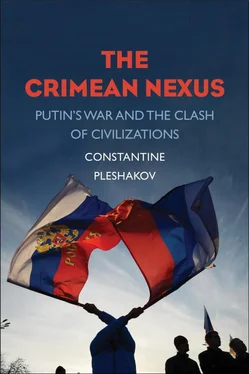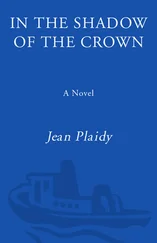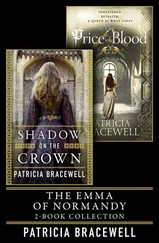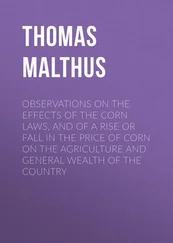The war between Russia and Crimea, which went on for four centuries, had nothing to do with grand strategy. The Ottoman Empire was already overstretched and could not possibly have been interested in subjugating Russia or wresting Ukraine away from Poland. The goal of the Ottomans and their Crimean client state was to maintain Russia and Ukraine as a permanent source of slaves.
At first, Russia’s military goal was just basic security in the south. Until the 1600s, the Crimean Khanate remained the stronger power, but even after the two had reached military equilibrium, the annual devastation of its southern provinces depleted Russia’s labor pool and kept the local economy at a subsistence level. As the Russian state strengthened, it found another goal in the war against the Crimean Khanate: to annex the fertile black earth belt, the Wild Fields, where Nogai Tatars lived. Later, still another motivation emerged: Russia’s perceived place in the clash of civilizations.
In an essay written in 1985 called “Flight from Byzantium,” a meditative Istanbul travelogue, Joseph Brodsky talks about observing “the aircraft carriers of the Third Rome sailing slowly through the gates of the Second on their way to the First.” [25] Joseph Brodsky, “Flight from Byzantium,” in Joseph Brodsky, Less Than One (New York: Farrar, Straus and Giroux, 1986), 446.
The trope is more meaningful than elegant.
The “Third Rome” concept is a noxious perennial of Russian history. Formulated around 1511 by an ecclesiastic named Philotheus from the Pskov Eleazer Monastery, it announced that after the fall of Rome and then of the Second Rome (Constantinople) because of their transgressions against true Christianity, the center of the world had moved to Moscow. “Two Romes have fallen, a third stands, a fourth there shall not be.” Within a few decades, this grand concept grew into Russian state doctrine. Not only did the princes of Moscow reinvent themselves as “tsars,” a corruption of “Caesar.” As James H. Billington puts it in his seminal interpretation of Russian history The Icon and the Axe , “All of Muscovy came to be viewed as a kind of vast monastery under the discipline of a Tsar-Archimandrite.” [26] James H. Billington, The Icon and the Axe: An Interpretive History of Russian Culture (New York: Vintage, 1970), 58; Madariaga, Ivan the Terrible , 10–11; 21.
An upstart community stuck on the periphery of Christianity and Islam, destitute even by the forgiving standards of sixteenth-century Europe, suddenly imagined itself the leader of humankind. Here is what made this happen.
After the fall of Constantinople in 1453, Russia became the only Orthodox country still standing. Its place in world affairs remained utterly humble—precisely the reason it had been allowed to survive, as no foreign conqueror was interested in the cold and wet patch of landlocked woods that was Russia at the time. It is not even mentioned in The Alexiad , a war and diplomacy treatise by the twelfth-century Byzantine princess Anna Komnene. [27] Anna Komnene, The Alexiad (New York: Penguin, 1969), xix.
To reformulate their country, Russians needed an intellectual push from the outside; it appears to have come from an exceptional European woman, Princess Sophia Palaeolog. Born Zoe, the niece of the last Byzantine emperor, and raised as a ward of Pope Paul II, she was married off to the grand prince of Moscow, Ivan III, in 1472. One example of her strong influence on her husband and his court is the Kremlin: the architects invited to build it came from Italy, and its walls and towers bear a striking resemblance to the Milan castle of the Sforzas, from the color of the bricks to the swallowtail merlons.
Sophia believed Russia could ally with Catholic Europe against the Ottomans and reclaim her ancestral Constantinople for her children. The concept of Rome as a wandering imperial capital had been the foundation of Constantinople (Anna Komnene mentions in passing that “power was transferred from Rome to our country and the Queen of Cities”). Though centered in the east, the empire still called itself “Roman”; the misleading term “Byzantium” did not come into general use in European languages until the nineteenth century. [28] Madariaga, Ivan the Terrible , 17–19; Catherine Merridale, Red Fortress: History and Illusion in the Kremlin (New York: Metropolitan, 2013), 49–64; Komnene, The Alexiad , 39, 397.
The Third Rome was part of Sophia’s dowry, and came from the Byzantine ecclesiastical tradition, yet Moscow had little sway in the Greek-speaking parts of Christendom. However, all Slavic Orthodox territories, such as Serbia, Bulgaria, and of course Ukraine, shared a sacred language with Russians—the Church Slavonic, adapted from the ninth-century Macedonian dialect. That made the Third Rome transnational community possible—“imaginable,” in Benedict Anderson’s words. To use another term from Anderson, the Third Rome concept was nothing but “territorialization of faith.” [29] Anderson, Imagined Communities , 15, 17.
In later centuries, the idea became Russia’s damnation. Peter the Great, an adept of realpolitik, saw little value in waging war against the Ottomans when a shorter way to Europe lay in the north. But for later Romanovs, “returning the cross” to the top of the Hagia Sophia in Constantinople became an obligation. Pursuing the mirage of the Third Rome, they dragged Russia into one war after another in the Black Sea area and in the Balkans. As late as World War I, to keep Russia as an ally, Britain and France promised Tsar Nicholas II Constantinople, the Bosporus, the Sea of Marmara, and the Dardanelles. After World War II, Stalin demanded that Turkey hand over control of the straits (the Bosporus and the Dardanelles), a push that made the White House respond with the Truman Doctrine, explicitly protecting Turkey and Greece from Russian aggression.
For Russians, the road to Constantinople started in Crimea. Russian troops stormed Perekop in 1736 and sacked most of the peninsula before being forced to withdraw. The next generation of generals was more successful. In 1771, Russians again occupied the peninsula; this time, the Ottoman government in Kaffa evacuated to Istanbul.
Russia’s ruler at the time was Catherine the Great. Far ahead of her time, extraordinarily successful in her conquests and diplomacy, she and her inner circle of advisers made the grandiose decision that Crimea would be a stepping-stone in the transformation of the eastern Mediterranean. Catherine was certain that the Ottoman Empire was ready to crumble. Having named her eldest grandson after Alexander the Great, she named the second Constantine, as he was destined to be the king of Constantinople, the capital of a “Greek monarchy.” Her lover, Grigory Potemkin, would become king of “Dacia”—an imagined country roughly contiguous with modern Romania. She modestly referred to this entire plan as her “Greek Project.” [30] Alexander, Catherine the Great , 247; Orlando Figes, The Crimean War: A History (New York: Picador, 2010), 13; Montefiore, Potemkin , 219–220, 242.
Catherine’s conquests on the Black Sea met with widespread approval in Europe. The Ottoman Empire was a traditional foe that had last laid siege to Vienna just a century earlier. Feeling very secure, Catherine started with an experiment: in 1774, Russia and Turkey signed a treaty establishing Crimea as an independent state. For the Ottomans, the khanate would be a buffer zone, and for Catherine a test site for what would centuries later be called “nation-building.” Her Greek monarchy and Dacia would have to be built from the Ottoman bureaucratic and social fabric. She thought Crimea was perfect for trying this out.
Читать дальше












